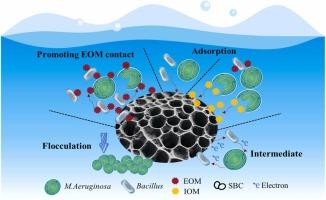形状生物炭强化枯草芽孢杆菌灭活铜绿微囊藻的性能及机理研究
IF 11.3
1区 环境科学与生态学
Q1 ENGINEERING, ENVIRONMENTAL
引用次数: 0
摘要
寻找一种经济有效的解决有害藻华(HABs)的方法是全球的优先事项。虽然微生物法被认为是一种有前途的、环保的、易于使用的除藻技术,但它的效率低、处理时间长。在功能微生物的开发中,环境功能材料(如粘土矿物、碳材料)已经证明了增强微生物活性的潜力,但关于微生物去除蓝藻的研究很少。本研究开发了一种碳基功能材料体系(颗粒活性炭和生物炭)来增强功能微生物对铜绿微囊藻的溶解能力,并探索了性能最优的生物炭-芽孢杆菌体系的解藻机理。在最优条件下,8天内叶绿素a去除率超过92%,4个循环后裂解效率保持85%。结果表明,芽孢杆菌对藻类的脱除包括直接脱除和间接灭活。生物炭的多孔结构为芽孢杆菌、藻类细胞及其分泌物提供了吸附位点,促进了高效的界面反应,提高了去除效率。此外,生物炭稳定系统,促进藻类絮凝,并促进电子转移。本文章由计算机程序翻译,如有差异,请以英文原文为准。

Enhancement of Bacillus subtilis inactivated Microcystis aeruginosa by shaped biochar: Performance and mechanism study
Finding a cost-effective solution to harmful algal blooms (HABs) is a global priority. While the microbial method is seen as a promising, eco-friendly and easy-to-use algae removal technology, it is limited by low efficiency and long treatment times. In the development of functional microorganisms, environmentally functional materials (e.g., clay minerals, carbon materials) have demonstrated potential to enhance microbial activity, yet little research exists on microbial Cyanobacteria removal. This study developed a carbon-based functional material system (granular activated carbon and biochar) to enhance functional microorganisms for dissolving Microcystis aeruginosa and explored the algal lysis mechanism of the biochar-Bacillus system with optimal performance. Under optimal conditions, over 92 % of chlorophyll a was removed in 8 days, with lysis efficiency retaining 85 % after 4 cycles. Results indicated algal removal by Bacillus involve direct removal and indirect inactivation. Biochar's porous structure provides adsorption sites for Bacillus, algal cells, and their secretions, fostering efficient interfacial reactions and improving removal efficiency. Additionally, biochar stabilizes the system, promotes algal flocculation, and facilitates electron transfer.
求助全文
通过发布文献求助,成功后即可免费获取论文全文。
去求助
来源期刊

Journal of Hazardous Materials
工程技术-工程:环境
CiteScore
25.40
自引率
5.90%
发文量
3059
审稿时长
58 days
期刊介绍:
The Journal of Hazardous Materials serves as a global platform for promoting cutting-edge research in the field of Environmental Science and Engineering. Our publication features a wide range of articles, including full-length research papers, review articles, and perspectives, with the aim of enhancing our understanding of the dangers and risks associated with various materials concerning public health and the environment. It is important to note that the term "environmental contaminants" refers specifically to substances that pose hazardous effects through contamination, while excluding those that do not have such impacts on the environment or human health. Moreover, we emphasize the distinction between wastes and hazardous materials in order to provide further clarity on the scope of the journal. We have a keen interest in exploring specific compounds and microbial agents that have adverse effects on the environment.
 求助内容:
求助内容: 应助结果提醒方式:
应助结果提醒方式:


